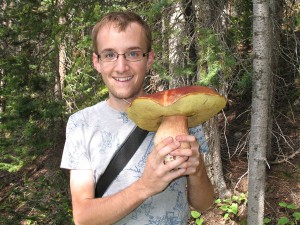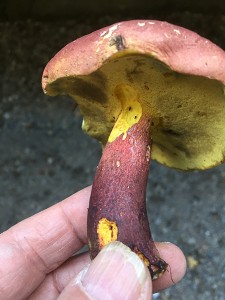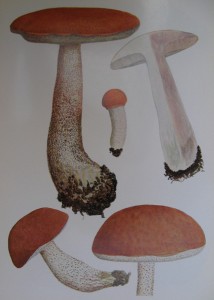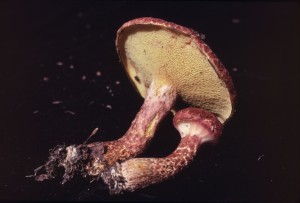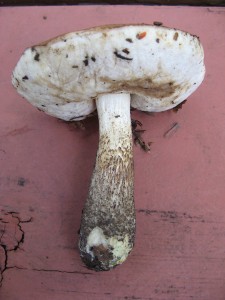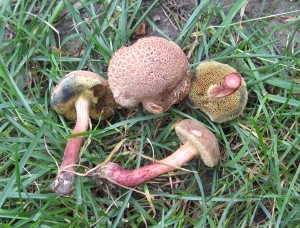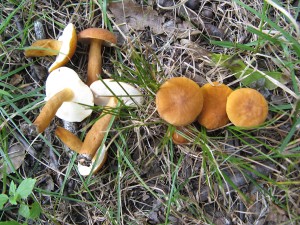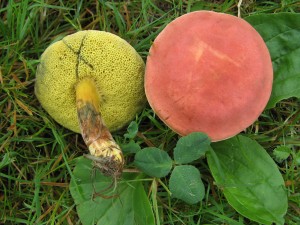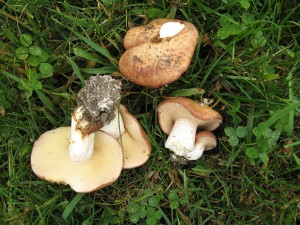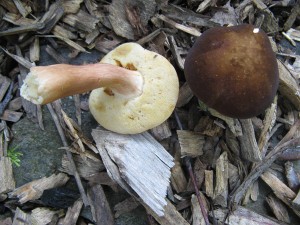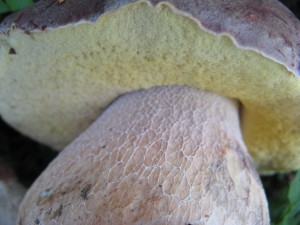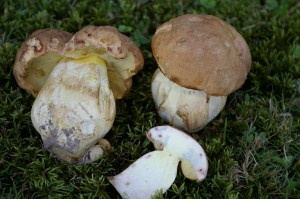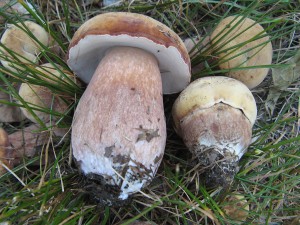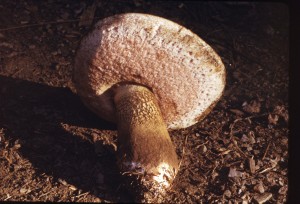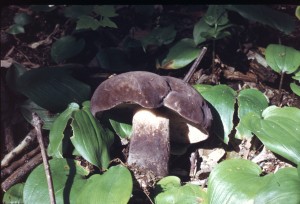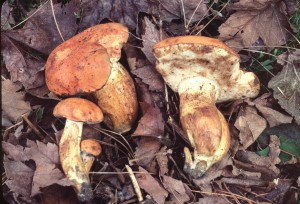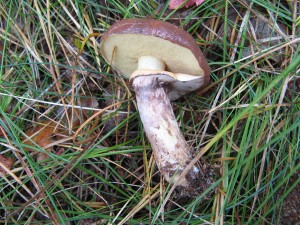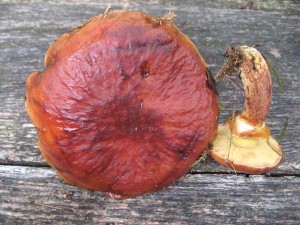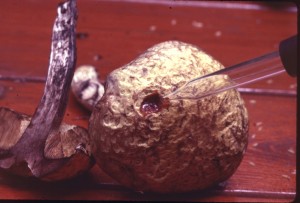Boletus edulis (Boletus rubriceps)
Boletus bicolor
This winter/spring we are studying BOLETES…..There are more than 125 boletus in the northeastern U.S., probably more than 150 species. Our task is to learn how to recognize as many of these as possible, and to understand the reasons for the names they have, especially those names that have been changed recently. [This photo is from Colorado - their version of "porcini," which is traditionally referred to there as Boletus edulis.]
Historical Note: When C.H. Persoon wrote his major work in 1803 the boletes and the polypores were considered a single large group of mushrooms. When Elias Fries wrote the last edition of one of his major works in 1874 the boletes and the polypores were split into two genera. When the Audubon Guide first appeared we had by then divided the boletes into several distinctive – and field recognizable – genera, maybe a dozen in all. Today, there are more than 30 bolete genera, and telling them apart by field characters is often not possible. Stay tuned for a way out of this emerging quagmire.
BOLETE QUIZ
Example:
Note cap color and stipe surface, also the bruising reaction on cutting open. Found under poplar, but also reported under aspen, birch, beech & oak, and some conifers…..
Answer: This is Leccinum aurantiacum in the broad sense.
A narrower circumscription of the species might separate those under conifers as a distinct species, as might those under oak, etc.
BOLETE QUIZ – SEE ANSWERS BELOW………….
COMA BOLETE QUIZ – #1 – This bolete only occurs attached to this false puffball – Scleroderma citrinum. What is it called? The false puffball is poisonous but the bolete is edible! Go figure.
COMA BOLETE QUIZ – #2 – Only one kind of bolete around here looks like this – What’s it called? Is it edible?
COMA BOLETE QUIZ – #3 – This red-pored bolete blues on bruising and has a very distinctive stem. It’s edible but some people think it too beautiful to eat.
COMA BOLETE QUIZ – #4 – This scaly-red dry capped bolete is found ONLY under 5-needle pine (white pine). What’s this edible bolete called?
COMA BOLETE QUIZ – #5 – This brownish-gray capped bolete occurs under birch and aspen trees. Its stem is distinctive: it has blackish hairs (called scabers) dotting it. It’s edible but not choice.
COMA BOLETE QUIZ – #6 – This cracked-cap bolete has red showing through the cracks, pores that stain blue on bruising, and it occurs in grassy areas near oak trees. It’s a so-so edible. What’s it called?
COMA BOLETE QUIZ – #7 – This hollow-stemmed oak loving bolete has an orange-brown cap and stem and white pores that mature yellowish. It’s edible and good. What is it?
COMA BOLETE QUIZ – #8 – This bolete has large, angular pores. The cap can be ruby red when first up. The pores stain blue. It’s found in grassy spots near oak trees. It’s edible. What is it?
COMA BOLETE QUIZ – #9 – This slimy capped bolete occurs under 5 needle pine (white pine). The stem has reddish dots near the apex. What is it? It’s a so-so edible.
COMA BOLETE QUIZ - #10 – This common bolete occurs under oaks. It has a dark brown cap and yellowish spores. The cap surface can be dotted so that it almost looks like a night sky star pattern. What is it. It’s a good edible.
COMA BOLETE QUIZ – #11 – This is one of our American King Boletes. What name shall we call this choice edible bolete?
COMA BOLETE QUIZ – #12 – This Bill Yule photo shows it at its best. A large meaty bolete with yellow pores and flesh. It stains blue on cutting, but slowly and faintly. Eat it and you’ll throw up. What’s its name?
COMA BOLETE QUIZ – #13 – This bolete looks like the King Bolete but its pores turn a dirty pinkish on maturity. It’s a very good edible, but what’s its name?
COMA BOLETE QUIZ – #14 – This very bitter bolete is something you find nearly always insect-free and all the more disappointing because of it. Note pinkish pores and black network on upper stem. What’s its name?
COMA BOLETE QUIZ – #15 – This velvety black capped bolete has a white pore surface when young, giving it its name “white and black” bolete.
COMA BOLETE QUIZ – #16 – This burnt orange bolete is common in sandy soils, like those found on Long Island. It’s not really edible – too bitterish.
COMA BOLETE QUIZ – #17 – This slimy capped bolete occurs under 2 & 3 needle pines. It has a veil leaving a purplish-gray baggy ring on the stem. Its common name is Slippery Jack. What’s its scientific name?
COMA BOLETE QUIZ – #18 – Found only under larch trees, this slimy capped bolete can have a reddish or yellowish cap. It’s also got a veil, leaving a ring on the upper stem. It’s edible if you insist.
COMA BOLETE QUIZ – #19 – Only under larch – usually larch (tamarack) bogs – Note the radial arrangement of the pores. Know this one?
COMA BOLETE QUIZ – #20
DO NOT LOOK AT THE ANSWERS BELOW UNTIL YOU HAVE GIVEN THESE PHOTOS YOUR BEST GUESS.
—————————————————————————————————————————————-
AMMONIA and KOH (POTASSIUM HYDROXIDE) – TWO SIMILAR BUT NOT IDENTICAL MACROCHEMICAL TESTS ON BOLETES
A GREEN FLASH ON THE CAP SURFACE OF XEROCOMUS (BOLETUS) ILLUDENS
A RED COLOR ON THE CAP SURFACE OF LECCINUM RUGOSICEPS
AMMONIA reaction on a dozen bolete cap surfaces
AND bruising reactions of context (flesh) when cut and exposed to air
(See “North American Boletes” for data on these and other boletes)
Boletus huronensis (context bluing slowly, sometimes slightly)
Ammonia: Green flash then orange
(no reaction on B. edulis; no bluing on context when cut)
Boletus subcaerulescens (context unchanging; pore surface staining blue)
Ammonia: Bluish green then bright orange surrounded by dull grayish green, then entirely yellow-orange (no reaction on B. edulis)
Boletus innixus (context not bluing)
Ammonia: Green flash then dull orange-red
Boletus pseudosensibilis (context quickly blue when cut)
Ammonia: Blue then dull purplish
(Yellow on B. sensibilis, whose context bruises blue quickly)
(Negative on B. bicolor, whose context bruises slightly blue if at all)
Boletus variipes (context unchanging)
Ammonia: Dark amber with a purplish black zone
Xanthoconium separans (context unchanging)
Ammonia: Lilac areas of cap and stem aquamarine to deep blue
Xerocomus badius (context bluing near the tubes, otherwise not)
Ammonia: Green to blue
Xerocomus illudens (context not bluing)
Ammonia: Bluish green
Xerocomus spadiceus (context unchanging or bluing slightly)
Ammonia: Green flash
Xerocomus subtomentosus (context unchanging or bluing slightly)
Ammonia: Reddish-brown
(negative to brownish on X. chrysenteron, which bruises blue conspicuously on the pores)
—————————————————————————————————————————————–
ANSWERS……………
1 – Boletus parasiticus
2 – Strobilomyces floccopus
3 – Boletus frostii
4 – Suillus pictus
5 – Leccinum scabrum
6 – Boletus chrysenteron
7 – Gyroporus castaneus
8 – Boletus campestris
9 – Suillus granulatus
10 – Xanthoconium affine (var. maculatum)
11 – Boletus edulis complex
12 – Boletus huronensis
13 – Tylopilus badiceps
14 – Tylopilus felleus
15 – Tylopilus alboater
16 – Tylopilus ballouii
17 – Suillus luteus
18 – Suillus grevillei
19 – Suillus paluster
20 – Boletus subvelutipes


